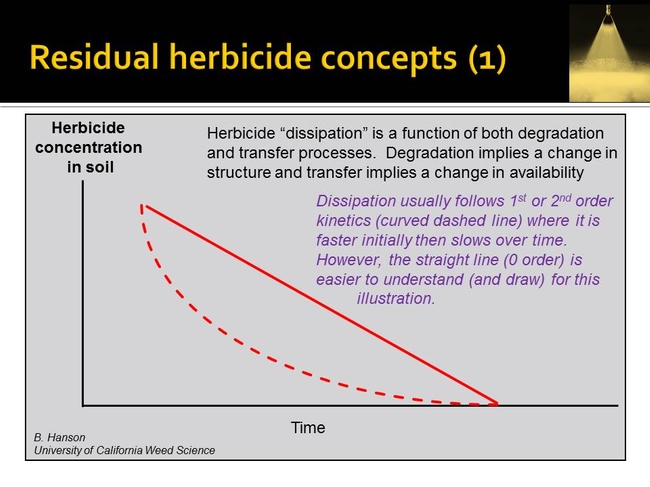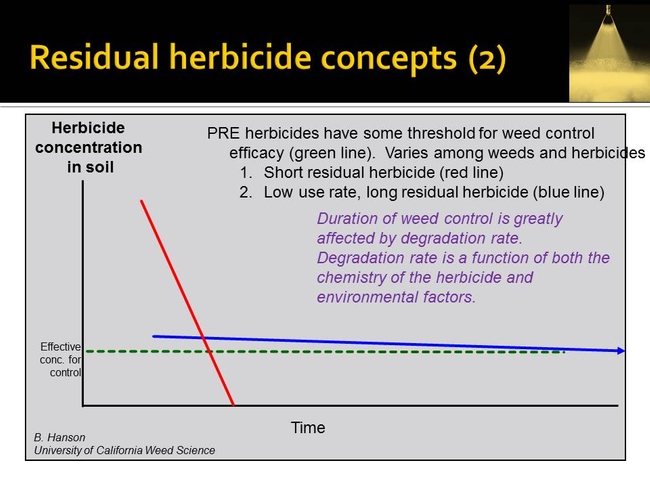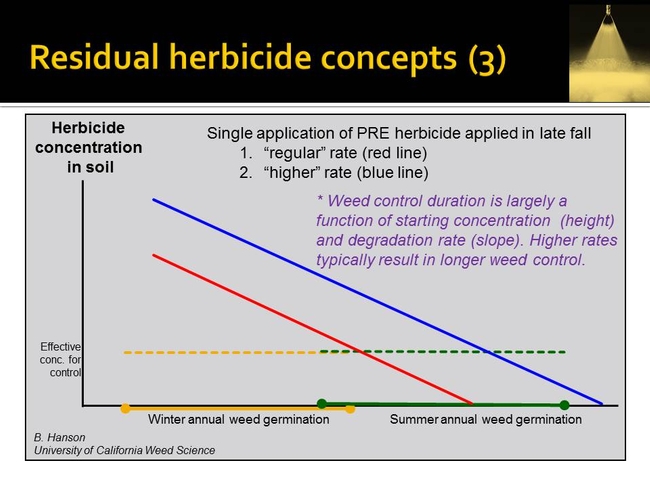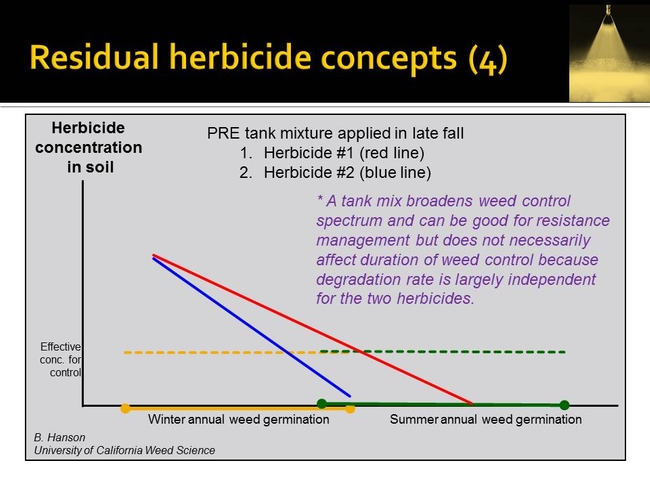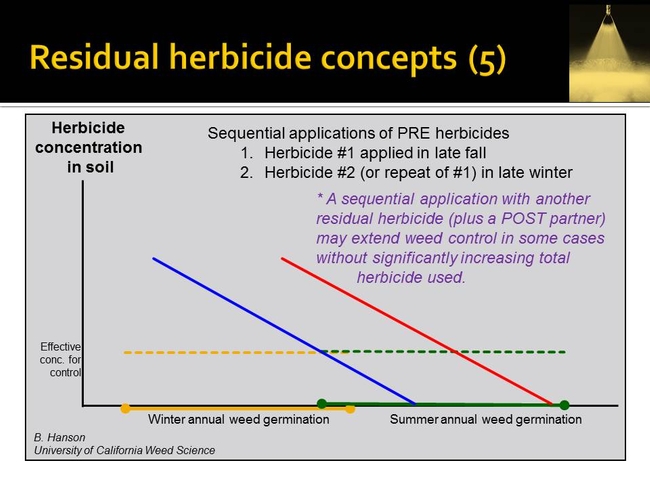It's that time of the year when we're planning preemergence (aka "residual") herbicide programs for orchard and vineyard crops in California. Typically, these are the herbicides that are applied in the fall, winter, or early spring BEFORE weeds emerge (preemergence) and they usually affect weeds as they germinate or are just beginning to emerge from the soil. [often, people mistakenly think these herbicides kill seeds or sterilize the soil which is not actually the case].
As you're planning the specific program for the weed problems in your orchards and vineyards (or any site, really), I thought it would be a good time to review some of the concepts of residual weed control with preemergence herbicides. Hopefully the concepts and ideas presented in the following line drawings will help us think about what PRE herbicides can and can't do, and how to best use them in the orchard and vineyard production system.
Herbicide dissipation - Dissipation (or disappearance) is a word that describes both degradation processes and transfer processes. Degradation is those processes that actually change the herbicide molecule into something else. Transfer processes are those that change the availability and could include binding to soil, leaching, volatilization etc. I won't dwell on those today but here's a link to a little longer writeup on that if you're interested. For today's discussion, I'll just make the point that all herbicides dissipate in the soil environment and that this usually follows what is called "1st order" or "2nd order" degradation kinetics - basically a curved line (see figure 1 below). This means that the processes happen faster at first and then slow down over time (red dashed line). However, to more easily illustrate this (and because it's easier to draw!), I'll use straight lines instead (red solid line below).
The whole point of residual herbicides is that they persist in the soil for a period of time and affect weeds that germinate after the application (days or months later, perhaps). There is a threshold of activity for the herbicide, basically this is a concentration in soil, above which the herbicide is effective on the weed and below which it is not (green dashed line in the figure below). This threshold will vary considerably among specific weeds and herbicides, though. [I've discussed this concept previously when talking about soil bioassays]. Another important concept on figure 2 is that residual herbicides can have very different dissipation rates which can result in different persistence in the soil, and different duration of residual weed control. For example, a short residual herbicide (red line) will fall below the activity threshold (green line) well before a very persistent herbicide (blue line).
To a certain degree, the length of weed control duration with a preemergence herbicide is a function of rate. A higher rate will remain above the activity threshold for longer than a lower rate of the same herbicide (see figure 3 below). In this slide, I also added in the concept of winter and spring germinating weeds. To me, this is one of the biggest challenges of using PRE herbicides in the orchard system - we typically apply our PRE herbicides in the winter when we'll get rainfall to incorporate them but the herbicides may dissipate too fast to control the late winter weeds or the summer-emerging weeds. Higher application rates in the winter is one approach to addressing this issue.
Often times, we'll use a tankmix of two or more PRE herbicides in the winter to broaden the weed control spectrum and reduce selection pressure for herbicide resistant weeds. While this is a good approach to managing diverse weeds, it does not really do much to "stretch" the weed control duration later into the summer because the dissipation processes of the individual herbicides are really independent of one another (see figure 4 below). In this figure, you can imagine that the weed control spectrum is much broader during the winter season than if only one herbicide was used; however, by the spring, there is probably not enough of the 2nd herbicide to provide much control.
Sequential applications of PRE herbicides is another way that weed control duration might be extended later into the season. This could be a sequence of two different herbicides as shown in figure 5 below where the first PRE herbicide was applied in the winter and a second PRE herbicide was applied in late spring. This might also be done with a repeat application of the first herbicide which could make sense in some situations (for example one application to target winter grasses (eg ryegrass) and another to target summer grasses (eg junglerice).
I think integrated weed management programs that include preemergence herbicides make a lot of sense for orchard and vineyard cropping systems. They can broaden the spectrum of weed control, they can reduce selection pressure for resistance to our POST herbicides, they can minimize spray trips through the field compared to multiple applications of POST herbicides, and can save management time. Just like any management tool, though, it's important to recognize what the limitations of PRE herbicides and plan accordingly to avoid over- or under-treating in any specific orchard/weed complex.
Take care,
Brad
